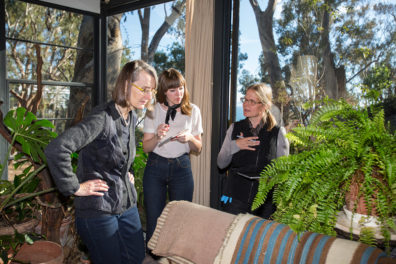
Associate Scientist Beril Bicer-Simsir placing a building material sample in the Universal Testing Machine.
Staff members of the Getty Conservation Institute (GCI) come from a great variety of disciplines. Chemists, architects, biologists, engineers, and other specialists lend their expertise to advance conservation of the world’s cultural heritage. Just as diverse as the staff’s backgrounds are the types of tools they use to aid the Conservation Institute’s conservation efforts.
Many of the Institute’s projects deal with the conservation of built heritage, including earthen architecture and historic buildings. Some of these structures have been around for thousands of years, meaning that parts of them are frequently in various states of deterioration and in need of intervention. For this, the Universal Testing Machine (UTM) comes in remarkably handy.
What Does the Tool Do?
Beril Bicer-Simsir is a civil engineer with a specialty in construction materials who works as an associate scientist at the Conservation Institute. She uses the Universal Testing Machine in the lab to determine the mechanical properties of original building materials—properties that describe how materials react to applied forces—and to identify and design compatible intervention options.
The UTM stands about seven-and-a-half feet tall. In between two tall columns is a horizontal beam called the cross head that can be raised or lowered. Samples of building materials such as marbles, plasters, and mortars are placed under the cross head to be tested under various stresses such as compression (when the material is shortened) or tension (when the material is extended).
The load cell—the part of the machine that directly touches the specimen—measures its different mechanical properties, such as how much the material deforms or how much load the specimen can take before it breaks. The data, which is unique to each material, can then be extrapolated to predict the behavior of the particular building material under stress.

A building material sample being tested.
How Does It Advance Conservation Practice?
Beril uses the UTM to test original materials from historical buildings as well as materials that may be used as replacements for any damaged or deteriorating areas. This replacement, however, should not necessarily be made out of the most durable materials. The design of the intervention needs to be mechanically compatible to the existing structure.
“Let’s say the replacement is stronger and more rigid than the original structure,” she explains. “What happens over time? The new material will start to damage the original material, compromising the entire structure. However, if the replacement is very weak, it’s not going to last. So the treatment would not be very efficient.” The UTM is used extensively in her lab to match the new materials to the existing materials.
Beril has also been involved in the Investigation of Alternative Backing Methods and Materials project, a component of the MOSAIKON Initiative. She designs backings for mosaics that have been lifted from their original support. In order to find the most cost-effective solution, scientists use computer models to help determine the optimal size and weight of backing systems using locally available materials. The UTM has been essential in providing data for this kind of optimization work.

Data from the testing is extrapolated to predict the behavior of the particular building material under stress.




I like all matters relating to the conservation and restoration of masterpieces, then this is something that interests me a lot.